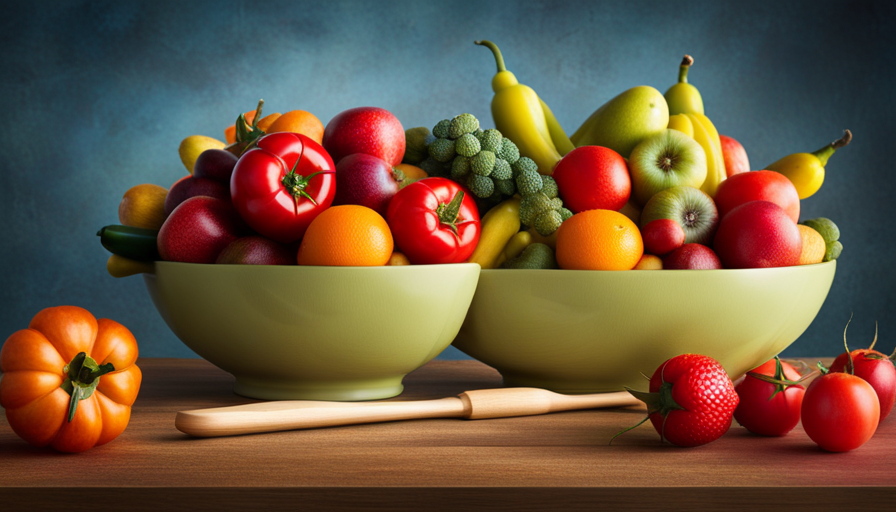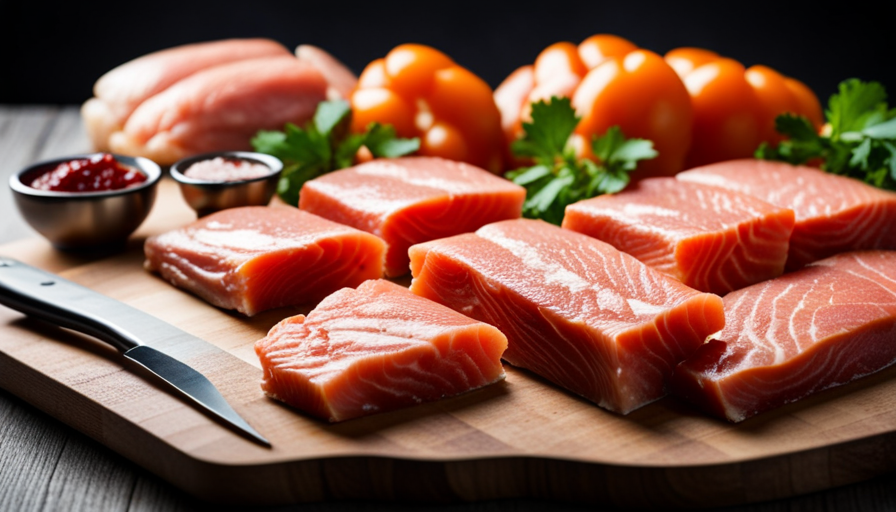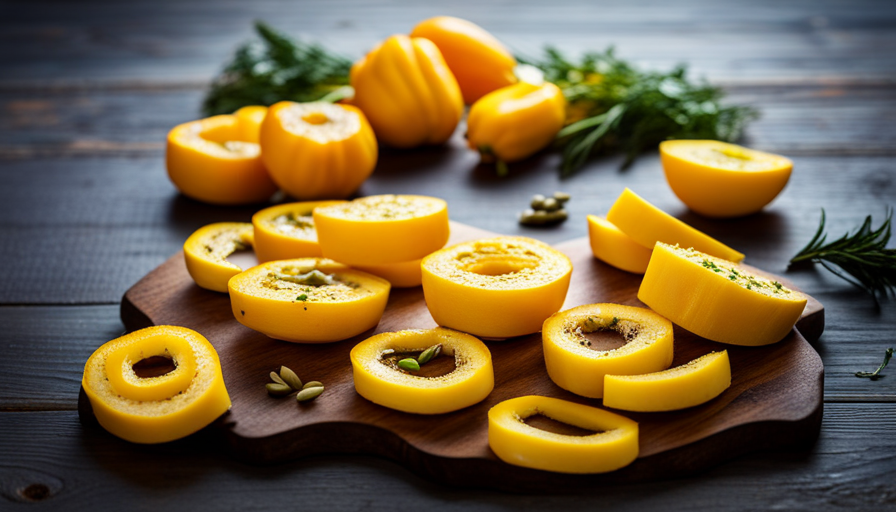Is there a jar of unprocessed honey gathering dust in your kitchen, poised for action? It’s now the perfect moment to tap into the immense possibilities this amber treasure offers for your cooking endeavors!
Raw honey is not only a sweetener, but it can also elevate the flavor of your favorite dishes and drinks. Picture this: a dollop of raw honey drizzling down a stack of warm pancakes, or a spoonful of honey-infused salad dressing perfectly complementing a bed of fresh greens. The possibilities are endless, and in this article, we will guide you through the art of using raw honey in food.
From enhancing the flavor of beverages to glazing meats and vegetables, from creating homemade honey mustard to exploring unique recipes, you’ll discover how this natural sweetener can transform ordinary meals into extraordinary culinary experiences.
So grab that jar of raw honey and get ready to embark on a delectable journey!
Key Takeaways
- Raw honey can be used as a sweetener in a variety of dishes and drinks, including cocktails, hot beverages, breakfast foods, and desserts.
- It can be used to create homemade salad dressings, sauces, and marinades, adding both sweetness and flavor.
- Raw honey can be used in baking as a healthier alternative to refined sugar, adding moisture, flavor, and health benefits to recipes.
- Honey glazes and honey-based condiments like honey mustard can be used to enhance the flavor of meats, vegetables, and stir-fried dishes.
Enhancing the Flavor of Beverages
Add a drizzle of raw honey to your favorite beverages for a burst of irresistible flavor! Raw honey isn’t just sweet, it’s also packed with nutrients, making it the perfect addition to enhance the taste of your drinks.
When it comes to enhancing cocktails, raw honey can be used as a natural sweetener that adds depth and complexity to your concoctions. Whether you’re mixing up a classic margarita or experimenting with a new signature drink, a touch of raw honey can take your cocktail game to the next level.
But it’s not just cocktails that benefit from the addition of raw honey. You can also infuse this golden goodness into your hot beverages. Whether you prefer a cup of soothing herbal tea or a rich and velvety hot chocolate, adding raw honey can elevate the flavor and bring out the natural sweetness of the drink. The heat from the beverage helps to dissolve the raw honey, allowing its natural flavors to infuse throughout the drink, creating a harmonious blend of taste sensations.
So, the next time you’re looking to enhance the flavor of your beverages, reach for a bottle of raw honey. Whether you’re shaking up a cocktail or sipping on a hot cup of tea, a drizzle of raw honey will add that extra touch of sweetness and depth that’ll make your drink truly unforgettable. Cheers to the power of raw honey!
Sweetening Your Morning Oatmeal or Yogurt
Enhance your breakfast bowl with a drizzle of nature’s golden nectar, turning your plain oatmeal or yogurt into a sweet symphony that dances on your tastebuds. Raw honey isn’t just a healthier alternative to processed sugars, but it also adds a delightful sweetness and depth of flavor to your morning meal. Here are some creative ways to incorporate raw honey into your breakfast routine:
-
Sweetening Tea: Instead of using sugar or artificial sweeteners, add a teaspoon of raw honey to your favorite tea. The natural sweetness of honey blends perfectly with the earthy flavors of tea, creating a delicious and soothing beverage.
-
Honey-Infused Pancakes: Take your pancakes to the next level by drizzling raw honey over them. The warm pancakes will absorb the honey, creating a sticky and sweet texture that’s simply irresistible. For an extra burst of flavor, you can also mix raw honey into the pancake batter itself.
-
Honeyed Yogurt Parfait: Layer your favorite yogurt with fresh fruits and a generous drizzle of raw honey for a delectable and nutritious breakfast treat. The honey adds a subtle sweetness and enhances the creamy texture of the yogurt, making each spoonful a delight.
By incorporating raw honey into your breakfast routine, you can elevate the taste of your morning oatmeal or yogurt and enjoy a healthier, more flavorful start to your day. So go ahead, indulge in nature’s sweet gift and savor the deliciousness it brings.
Creating Delicious Salad Dressings
Transform your ordinary salads into culinary masterpieces by crafting your own unique and flavorful dressings, allowing you to truly elevate your dining experience.
One way to create unique vinaigrettes is by experimenting with honey-based dressings. Raw honey adds a natural sweetness and depth of flavor that can enhance the taste of your salad.
To make a honey-based dressing, start with a base of olive oil and vinegar. You can use any type of vinegar you prefer, such as balsamic, red wine, or apple cider vinegar. Then, add a tablespoon of raw honey to the mixture. The honey will add a touch of sweetness and balance out the acidity of the vinegar.
For a tangy and refreshing dressing, you can mix in some lemon juice or Dijon mustard. These ingredients will add a zesty kick and complement the sweetness of the honey. If you like a bit of heat, you can also add a pinch of red pepper flakes or a dash of hot sauce.
Once you have combined all the ingredients, give the dressing a good whisk or shake to ensure everything is well blended. Taste and adjust the flavors to your liking.
Pour the dressing over your favorite salad greens and toss to coat.
By creating unique vinaigrettes and experimenting with honey-based dressings, you can turn a simple salad into a flavorful and satisfying meal. Enjoy the delicious combination of sweet and tangy flavors that only raw honey can provide.
Adding a Touch of Sweetness to Sauces and Marinades
To give your sauces and marinades a hint of sweetness, why not incorporate a dollop of golden nectar and let it work its magic? Raw honey can be a versatile ingredient that adds a touch of natural sweetness to your favorite savory dishes. When used in sauces and marinades, it not only enhances the flavor but also helps to tenderize the meat.
When making sauces, simply mix raw honey with other ingredients like soy sauce, garlic, and ginger for a delicious glaze. The honey caramelizes as it cooks, creating a rich and flavorful sauce that pairs perfectly with grilled meats or roasted vegetables.
For marinades, combine raw honey with olive oil, lemon juice, and herbs to create a sweet and tangy mixture that infuses the meat with flavor as it marinates.
Incorporating raw honey into your sauces and marinades is just the beginning. This versatile ingredient can also be used in desserts, like drizzling it over a bowl of fresh berries or adding it to a homemade ice cream recipe. Additionally, you can try incorporating honey into breakfast dishes, such as spreading it on toast or mixing it into yogurt for a sweet and nutritious start to your day.
So, next time you’re looking to add a touch of sweetness to your sauces, marinades, or even desserts and breakfast dishes, reach for a jar of raw honey and let its natural goodness shine.
Baking with Raw Honey
When you’re baking, don’t forget to incorporate the rich and sweet flavor of golden nectar by adding a dollop of raw honey to your recipes. Not only does it add a delicious twist to your baked goods, but it also brings a host of health benefits.
Here are some baking tips to make the most of raw honey in your creations:
-
Replace sugar with raw honey: Swap out the refined sugar in your recipes and use raw honey instead. It not only enhances the flavor but also adds moisture and a lovely caramel-like aroma to your baked goods.
-
Experiment with flavors: Raw honey comes in different varieties, each with its own unique taste profile. Try using different types of honey in your baking to add depth and complexity to your desserts.
-
For a floral touch, use wildflower honey.
-
For a robust flavor, opt for buckwheat honey.
Incorporating raw honey into your baking not only elevates the taste but also offers numerous health benefits. It’s rich in antioxidants, enzymes, and vitamins, making it a healthier alternative to processed sugars.
So go ahead, get creative in the kitchen, and let the golden goodness of raw honey transform your baked treats into something truly extraordinary.
Making Raw Honey-infused Granola or Energy Bars
Get ready to whip up a batch of delectable granola or energy bars infused with the golden goodness of raw honey. Raw honey-infused protein bars are not only a tasty treat but also a great source of energy and nutrition. By incorporating raw honey into your homemade energy bars, you can enjoy the natural sweetness and numerous health benefits it provides.
To make these raw honey-infused granola or energy bars, you will need a few simple ingredients. Here’s a handy table to guide you through the process:
| Ingredient | Quantity |
|---|---|
| Rolled oats | 2 cups |
| Almonds | 1 cup |
| Chia seeds | 2 tablespoons |
| Raw honey | 1/2 cup |
| Peanut butter | 1/2 cup |
| Vanilla extract | 1 teaspoon |
| Dried fruits | 1/2 cup |
| Dark chocolate chips | 1/2 cup |
Start by preheating your oven to 350°F (175°C). In a large mixing bowl, combine rolled oats, almonds, chia seeds, raw honey, peanut butter, and vanilla extract. Mix well until all the ingredients are evenly coated. Spread the mixture onto a lined baking sheet and bake for 15-20 minutes or until golden brown.
Once the granola mixture is cooled, add dried fruits and dark chocolate chips. Mix everything together and press the mixture firmly into a baking dish. Refrigerate for a few hours or until firm. Cut into bars or squares and enjoy these delicious raw honey-infused granola or energy bars as a healthy snack or on-the-go treat.
Incorporating raw honey into energy balls is another great way to enjoy its benefits. Simply combine raw honey with your choice of nuts, seeds, and dried fruits. Roll the mixture into bite-sized balls and refrigerate until firm. These energy balls make for a quick and nutritious snack, perfect for satisfying your sweet tooth while providing a boost of energy.
So, why not try incorporating raw honey into your homemade granola or energy bars? It adds a touch of natural sweetness and a whole lot of goodness to your snacks. Get creative with your ingredients and enjoy the benefits of raw honey in every bite!
Glazing Meats and Vegetables for a Flavorful Twist
Adding a glaze to your meats and vegetables creates a delightful burst of flavor that elevates your dishes to a whole new level. Whether you’re grilling a steak or roasting some carrots, incorporating raw honey into your glaze can take your culinary creations to the next level.
Here are some exciting ways to use raw honey as a glaze:
-
Glazing fruits for a sweet dessert: Brushing raw honey onto sliced peaches, pineapples, or even watermelon before grilling them enhances their natural sweetness and creates a caramelized and juicy treat that’s perfect for a summer dessert.
-
Incorporating raw honey into BBQ sauces: Upgrade your BBQ game by adding raw honey to your homemade sauce. The natural sweetness of honey balances the smoky and tangy flavors, creating a finger-licking glaze that’ll have your guests asking for seconds.
-
Drizzling honey glaze over roasted vegetables: Tossing roasted vegetables like Brussels sprouts or butternut squash in a honey glaze adds a touch of sweetness and a beautiful glossy finish. It creates a caramel-like coating that complements the earthy flavors of the veggies perfectly.
-
Glazing meats for a savory twist: Brushing raw honey onto grilled or roasted meats such as chicken, pork, or salmon adds a sticky, sweet glaze that caramelizes beautifully. The honey glaze not only enhances the flavor but also helps to lock in moisture, resulting in succulent and tender meat.
-
Adding a honey glaze to stir-fried dishes: A drizzle of honey glaze at the end of stir-frying adds a touch of sweetness and a glossy finish to your favorite Asian-inspired dishes. It creates a perfect balance of flavors and elevates your stir-fry to a restaurant-quality dish.
With these creative ways to incorporate raw honey into your glazes, you can add a unique and delicious twist to your meats, vegetables, and even desserts. So, go ahead and experiment with raw honey to take your cooking to new heights!
Creating Homemade Honey Mustard
Crafting your very own honey mustard is like conjuring a golden elixir that dances on your taste buds, blending the sweet notes of honey with the tangy kick of mustard. It’s a versatile condiment that can elevate any dish, from sandwiches to salads, and even roasted meats.
To make a homemade honey mustard, you’ll need just a few simple ingredients: honey, Dijon mustard, mayonnaise, apple cider vinegar, and a pinch of salt and pepper. Start by whisking together ¼ cup of honey, ¼ cup of Dijon mustard, 2 tablespoons of mayonnaise, 1 tablespoon of apple cider vinegar, and a pinch of salt and pepper in a small bowl. Adjust the ingredients to your taste preferences, adding more honey for extra sweetness or mustard for a spicier kick.
Once you’ve perfected your homemade honey mustard, the possibilities are endless. Use it as a dipping sauce for chicken tenders or pretzels, spread it on sandwiches and burgers for a burst of flavor, or toss it with roasted vegetables for a delicious glaze. You can also experiment with different honey mustard varieties by adding ingredients like garlic, herbs, or even a splash of hot sauce. Let your creativity flow and enjoy the delightful combination of honey and mustard in your homemade creations.
Incorporating Raw Honey into Smoothies and Frozen Treats
One great way to amp up the flavor and sweetness in your smoothies and frozen treats is by incorporating some delicious, all-natural raw honey. It not only adds a natural sweetness but also offers a unique depth of flavor that other sweeteners simply can’t match.
When it comes to smoothies, the possibilities are endless. You can start by adding a tablespoon or two of raw honey to your favorite fruit smoothie recipe. It pairs beautifully with berries, tropical fruits, and even citrus. The honey blends seamlessly into the smoothie, giving it a silky texture and a hint of sweetness that’ll leave you craving for more.
If you’re in the mood for a frozen treat, raw honey can take your dessert game to the next level. You can drizzle it over homemade frozen yogurt or blend it into your ice cream base for a delectable honey-flavored treat. You can also use it as a sweetener for popsicles or slushies. The possibilities are endless, and the flavor combinations are only limited by your imagination.
Incorporating raw honey into your smoothies and frozen treats is a simple yet effective way to elevate their flavor and sweetness. So go ahead, experiment with different smoothie recipes and frozen dessert ideas, and enjoy the natural goodness that raw honey brings to the table.
Exploring Unique Raw Honey Recipes
Ready to discover some mouthwatering recipes that’ll take your taste buds on a sweet and flavorful journey? Well, get ready because we’re about to explore some unique raw honey recipes that’ll leave you craving for more.
Not only is raw honey a delicious natural sweetener, but it also has numerous health benefits. Did you know that it’s great for your skin too? That’s right! Raw honey can be used in honey-based skincare products, like face masks and exfoliators, to nourish and hydrate your skin. So, not only will you be satisfying your sweet tooth with these recipes, but you’ll also be giving your skin a healthy treat.
One delicious recipe to try is honey-glazed salmon. The combination of the sweet honey glaze with the savory salmon creates a mouthwatering dish that’s both healthy and flavorful.
Another unique recipe is honey-roasted carrots. The natural sweetness of the honey enhances the natural flavors of the carrots, making them a delicious and nutritious side dish.
Incorporating raw honey into your recipes not only adds a unique flavor but also provides you with the health benefits of raw honey. So, grab a jar of raw honey and start exploring these amazing recipes today! Your taste buds and skin will thank you.
Frequently Asked Questions
Can raw honey be used as a substitute for sugar in baking?
When it comes to baking, raw honey can be a fantastic substitute for sugar. It offers a myriad of nutritional benefits and adds a touch of natural sweetness. Additionally, raw honey contains beneficial enzymes, antioxidants, and trace minerals. To use raw honey as a sugar substitute in baked goods, simply replace each cup of sugar with 3/4 cup of honey. Keep in mind that honey is sweeter than sugar, so you may need to adjust the other ingredients accordingly.
How long does raw honey last once opened?
Once opened, raw honey has a shelf life of about one to two years. To ensure its freshness, store it in a cool, dry place away from direct sunlight. Avoid keeping it near heat sources as it can cause the honey to crystallize. It’s recommended to tightly seal the container after each use to prevent moisture absorption. With proper storage tips, you can enjoy the rich flavor and numerous health benefits of raw honey for an extended period.
Is raw honey safe for infants and young children?
Raw honey is a delicious and natural sweetener that offers many benefits. However, it’s important to note that raw honey isn’t safe for infants under one year old. While raw honey provides numerous health benefits, such as antioxidants and antibacterial properties, it can also contain harmful bacteria that infants’ immune systems aren’t yet equipped to handle. It’s best to wait until your child is older before introducing them to the wonders of raw honey.
Can raw honey help with allergies?
Raw honey can indeed help with allergies. It contains pollen from local plants, which can help desensitize your immune system to these allergens. This means that consuming raw honey regularly can potentially reduce allergy symptoms over time.
Additionally, raw honey is packed with antioxidants and has antibacterial properties, which can further support your immune system. So, incorporating raw honey into your diet can have numerous benefits for your overall health and well-being.
What is the difference between raw honey and regular honey?
Raw honey and regular honey differ in their production process. Regular honey undergoes pasteurization, which involves heating and filtering, to remove impurities and extend shelf life. On the other hand, raw honey is unprocessed and directly extracted from the hive. This means it retains all its natural enzymes, antioxidants, and nutrients.
These health benefits, including antibacterial properties and allergy relief, are often lost in the production of regular honey.
Can Raw Honey Help Soothe a Raw Throat From Food Poisoning?
Raw honey can be a helpful natural remedy for treating a raw throat from food poisoning. It has antibacterial and anti-inflammatory properties that can soothe the throat and provide relief. Consuming raw honey may also help alleviate symptoms of food poisoning and promote healing.
Conclusion
So there you have it, folks! Now you know all the amazing ways to use raw honey in your food. But let’s be honest, who needs all these fancy recipes anyway? Just stick to your plain, boring food and miss out on the incredible flavors that raw honey can bring.
Who needs a touch of sweetness in their sauces or a glaze on their meats? Certainly not you! So go ahead, keep living that bland and uninspired culinary life. It’s your loss, really.










